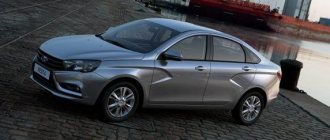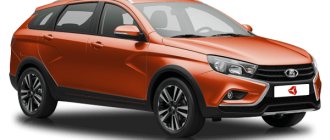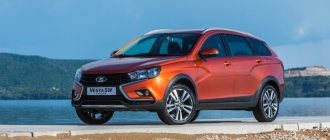Underpay for
Crossovers are the fastest growing segment of the Belarusian car market, and Hyundai Creta is one of the popular models in this class. But won't the situation change with the advent of the Lada Vesta SW Cross station wagon, just as practical, but more affordable? We decided to find out whether it makes sense to overpay for Creta when you can underpay for Vesta SW Cross.
All power to crossovers!
Golf class sedan? Yes, we have already forgotten what it is! Crossovers are in fashion today, which, despite their higher price, displace regular passenger cars from the top 10 sales. A real example: in 2017, a Hyundai dealer sold 845 Creta crossovers in Belarus, while the Accent sedan sold only 621 cars.
The Lada Vesta SW Cross all-terrain station wagon cannot yet boast of such successes, since its sales started only at the end of 2022. But if you consider that this is, in fact, the only pseudo-off-road station wagon on the market, and also quite beautiful, the prospects look very rosy. Many buyers see the Cross as an alternative to a crossover. Are such hopes justified? Is it worth overpaying for a crossover or is it really better to take a raised station wagon? And is Lada even able to stand comparison with Hyundai?
In the budget segment, sedans rule the roost, but Lada bet on a station wagon and was right, because there are practically no competitors
How much?
As mentioned above, the Lada Vesta can be a station wagon in two guises - a regular SW and an elevated SW Cross. The difference between them is the ground clearance (178 and 203 mm), as well as the protective plastic around the perimeter of the body, which is a feature of the Cross version.
At the same time, Cross is considered a more status model and is not offered in basic versions, which significantly affects the price. If a regular SW with a 106-horsepower 1.6-liter engine is available starting with the Comfort package and costs from 23,420 Belarusian rubles, then Cross 1.
6 in our market is offered at least in the Luxe configuration and costs 27,820 Belarusian rubles (for comparison: Lada Vesta SW Luxe 1.6 will cost 25,880 rubles).
The SW Cross Luxe's equipment is very good - front and side airbags for front passengers, ISOFIX, daytime running lights, fog lights, all electronic assistants, including TCS and ESC, on-board computer, central armrest with box, double luggage compartment floor, electric power steering , adjustable steering wheel for height and reach, cabin air filter, light tinted windows, central locking with folding key control, front and rear electric windows, 3-level heated front seats, heated and electric mirrors, heated windshield, parking sensors, rain sensors and lights, climate control and cooled glove box, multifunction steering wheel and audio system with 4.3-inch monochrome display, rear spoiler, 17-inch alloy wheels, decorative exhaust tip, two-tone interior - what more could you want? Normal multimedia system. And it comes in the Luxe Multimedia package (as on the test car) - with navigation and a 7-inch color touchscreen. This Vesta SW Cross with a 1.6-liter engine costs 28,710 Belarusian rubles, and with a 122-horsepower 1.8-liter engine costs 29,640 rubles. The most expensive Vesta SW Cross is the Luxe Prestige version with a 1.8-liter engine and an AMT robotic gearbox, for 31,220 Belarusian rubles.
Hyundai Creta has already become familiar, but it looks well-built and harmonious
The price list for the Hyundai Creta starts even higher - for the basic front-wheel drive Active version with a 1.6-liter 123-horsepower engine they ask for 33,900 Belarusian rubles.
The equipment of the base Creta is also quite good - all assistants, led by a stabilization and traction control system, heated seats and mirrors, power windows, central locking with key control, an audio system with steering wheel controls, etc.
However, in the basic version there are only 2 front airbags, instead of climate control there is air conditioning, and the steering wheel in the initial versions is adjustable only in height. Do you want to upgrade? Then, if we are talking about a front-wheel drive version with a manual transmission, you will have to step up one configuration, to the Travel version, which costs 37,900 Belarusian rubles.
Its equipment is noticeably better: there are side and window airbags in the front, rear parking sensors and tire pressure sensors, daytime running lights are LED, the steering wheel is adjustable for reach and equipped with heating, the wheels are shod with 16-inch alloy wheels (for basic Cretas - “stamping” "), optitronic instrument panel, climate control and additional high-frequency speakers in the doors.
To get a heated windshield, an audio system with a 5-inch color display, light sensors, cruise control and other nice little things, you will have to step even further, to the mark of 39,900 Belarusian rubles, which are asked for the Elegance package. In general, the difference between the front-wheel drive Lada Vesta SW Cross 1.8 and Hyundai Creta 1.6 (both with manual transmission) in more or less comparable configurations is quite significant.
Is this an extra payment for better quality, brand or the proud title of a crossover? Let's see.
What is inside?
In the Elegance package (only the Style is higher), the interior of the Hyundai Creta looks neatly conservative, but you can immediately feel how meticulous the Koreans are in creating configurations.
Even in this far from basic version, the multimedia system screen has a diagonal of only 5 inches, which especially attracts attention when the rear view camera is activated - the image looks very small. The steering wheel is covered with the finest leather that is very pleasant to the touch, but the handbrake and gearbox levers are plastic.
They even managed to make the steering wheel adjustment for reach a privilege of expensive versions; the basic ones only have height adjustment. But it’s nice that not only the front but also the rear seats, as well as the steering wheel, are heated.
The interior of the Hyundai Creta is not very expressive, but is almost flawless in both ergonomics and quality
The build quality and ergonomics are impeccable. The plastic is pleasant to the touch, all the gaps are made simply with filigree precision, the comfortable seat has height adjustment, and the steering wheel, as mentioned above, has height and reach adjustments. All the little details, such as internal door handles, all kinds of handles and switches, were carefully worked out. Bottom line: the Creta may look a little boring inside, but we have absolutely no complaints about the quality and ergonomics. Adjusted for the fact that this is still a relatively budget car.
The interior of the Vesta SW Cross is memorable for its design and bright textures, but the materials are a little rougher
We talked about the ideal ergonomics of Vesta in the first tests of sedans two years ago and today we are ready to confirm: in terms of ease of entry, Lada is one of the best in its and neighboring segments. The range of adjustments for the steering wheel and driver's seat is especially impressive.
The work of the designers can also be praised - it is original and memorable, and there are no questions about convenience. But according to Vesta materials it’s simpler. This also applies to multi-textured plastic, bright inserts on the doors, and a steering wheel without leather upholstery.
The build quality can be called amazing for a Russian car, but if we talk about the interior in comparison with the Creta, then objectively it looks and feels cheaper. Which is quite logical: Lada is cheaper.
Who lives well behind?
Passengers of the Vesta SW Cross will not feel constrained even behind a tall driver, but some will find the back angle too vertical. Heating is only available with the Prestige package
Changing to the back row behind you, even a tall person will not feel constrained in the Lada - there is plenty of room in the knees.
And if the driver has also raised his seat, then you can stretch your legs slightly, although in this position you feel the lower crossbar of the seat with your shins. The width of the cabin at the elbow level of the Lada is impressive - 150 cm, so the rear passengers will not feel any constraint. The central tunnel practically does not protrude into the cabin, which will certainly please the third passenger.
There are pockets in the backs of the front seats, but there is no center armrest. Another nuance is that the back of the rear seat is installed unusually vertically.
In terms of interior width, the Creta is slightly inferior to the Lada, but rear seating is more comfortable and there are heated seats
In the Creta, the seat back is set at a more comfortable angle, and the seats themselves are higher, which makes the seating more comfortable. The central tunnel also practically does not interfere with the legs, the feet fit comfortably under the front seats, but there is no armrest in the back either, and there is a pocket only on the back of the navigator’s chair. In terms of interior width, the Creta is slightly inferior to the Lada - at elbow level it is 144 cm, but rear passengers can enjoy heated seats.
Luggage cases
The luggage compartment of the Lada Vesta SW Cross is impressive both in size and convenience - it has niches in the sides, organizers, and a spacious underground
The trunk is the station wagon's calling card, and Lada displays it with pride. The standard volume is 480 liters, in the floor there are two organizers with lids, and under them there is also a spacious underground, in a niche with a spare wheel. Little things can be shoved around so that you won’t find them right away! Larger items can be stored in niches on the sides - on the right there is a box that closes with a lid, on the left there is a mesh and Velcro for fixation. The doorway width is 97 cm, the maximum trunk width is the same.
The trunk of the Hyundai Creta is smaller in capacity, but the doorway is wider and the width of the trunk itself is larger
For carrying luggage, the Hyundai Creta offers less usable volume - 403 liters. But its trunk itself is more convenient for transporting large items, so the width of the opening and the trunk itself is noticeably larger - 110 cm versus 97 for the Lada. Otherwise, everything is similar: there is a niche in the underground near the spare wheel, and there are side pockets with Velcro.
Universex
The cargo-passenger Vesta has entered production, sales will start in the fall. And if the sedan became the new face of Lada two years ago, then the Vesta station wagon is definitely its new body. The national economic term “body type” is completely inappropriate here; the English version is much more accurate: Vesta has a new body style. This is the sexiest domestic car since the G8!
Westonomics
Our auto industry has always taken a pragmatic approach to the creation of station wagons: cargo-and-passenger Muscovites, Volgas and even Chaikas were born in order to immediately become ambulance, delivery or ritual transport. For four decades, the universal Lada Zhiguli was dressed according to the patterns of the Fiat 124 Familiare model. And even the relatively modern “eleventh”, Priora and Kalina inherited this proletarian boxy style. And Vesta is sexy.
Why did former AvtoVAZ President Bo Andersson decide in the spring of 2015 to postpone the launch of the Vesta hatchback and focus on the version with a cargo-passenger body?
AvtoVAZ's initial strategy envisaged that a hatchback would appear after the sedan. But the five-door body needed a serious transformation (the rear overhang was supposed to be shortened by about 150 mm), and demand would have to be shared with the XRAY model. It is not surprising that Vesta Hatch was recognized as the weakest link.
But the concept of a station wagon with a unified floor from the sedan looked more logical. The body below the sill line required almost no redrawing, and the floor, the lower part of the trunk opening, the bumper and even the lights remained identical. True, with this approach it is problematic to make the trunk much larger than the original one (for the sedan it is 480 liters), and besides, a high threshold remains in the opening. And you also need to elegantly marry the “bottom” of the sedan with the new “top”. But here the experience of Steve Mattin, who spent most of his career in countries where any designer is ready to draw a “car” even with his eyes closed, came in handy.
Vesta Cross differs from the basic sedan and station wagon in its bumpers, protective apron around the perimeter of the body and suspension
— We didn’t intend to make Vesta a “cargo carrier”: that’s what Largus is for. Therefore, the result was an atypical station wagon - dynamic and sporty. This is a completely new segment for us, which has nothing to do with the “classics,” says Mattin.
By the way, for the same reason, the option of calling the Combi was not considered, despite the fact that, as in the case of the Granta-liftback, it would also suit Vesta. As a result, it was named in the Western style - Vesta SW, that is, station wagon, although no nameplates separately indicating versatility are provided.
Compared to the sedan, about 60 new parts have appeared in the body structure, including reinforcements, which should maintain body rigidity after removing the shelf behind the second row of seats. The frame of the rear door window has become higher (the opening has also increased), the roof is flatter, which means that, unlike the Vesta sedan, there should be an acceptable amount of space above the heads of the rear passengers. The C-pillars are angled forward almost like a hatchback, and the fifth door connector runs along the top of them, outlining a shark fin.
In terms of body length and width, the base station wagon is identical to the sedan, but 15 mm higher. Vesta Cross is raised by another 25 mm and slightly wider due to the wheel arches
As a result, looking at Vesta, it’s hard to escape the thought that the designers and marketers wanted to make not so much a roomy station wagon, but a compact SUV. This is especially noticeable in Vesta Cross.
The “cross” version will go on sale simultaneously with the base station wagon, from which it is distinguished by a plastic body kit, 17-inch wheels and ground clearance increased from the base 178 mm to 203 mm! Therefore, if an ordinary station wagon finds itself in a company with cargo-passenger versions of Ford Focus and Kia cee'd cars, each of which it is inferior in size, then the Vesta Cross can already be compared with the Renault Duster crossover: the Lada surpasses it in both length and ground clearance!
Towards the variator?
AvtoVAZ has not yet officially released information about engines and transmissions, but it’s hard not to notice the 1.8 nameplates on the rear of both station wagons. Under the hood of the Vesta sedan, this engine develops 122 hp.
, but still only works in tandem with the AMT “robot”, although on the XRAY crossover a “mechanics” is also available with it (AvtoVAZ uses the French JR5-523 transmission). There are also unofficial signals that a manual transmission will appear on Vesta 1.
8, began arriving from Togliatti last year, so it is very likely that the station wagon will be the first to receive both types of transmission. And since the station wagon is heavier, the main gear will most likely become “shorter”.
The fiery color Mars suits Vesta Cross best, which will be introduced into the palette simultaneously with the launch of station wagons
And we can say with almost complete confidence that the VAZ 1.6 engines paired with the 2180 “mechanics” and the AMT-2182 “robot” will remain the base for station wagons.
But let’s not forget that AvtoVAZ is looking with renewed vigor for an alternative to its “robot” - export markets demand this. Among the options, a variator from the arsenal of the Renault Nissan alliance is also being considered (and it uses Jatco units), however, adaptation of the new transmission will certainly take a lot of time, and an alternative gearbox is unlikely to be ready by the start of production of station wagons.
How can it be profitable to buy a Lada Vesta in any configuration?
Regardless of what class of Lada Vesta car or what class of Lada Vesta SV Cross car, it is important to profitably purchase absolutely any configuration without overpaying. If the car is sold by an official Lada dealer, the configurations of any model (except CNG) can be customized thanks to a wide selection of various add-ons and options. This solution allows you to literally create a car that will meet both your financial capabilities and your expectations. However, for those who would like to purchase a more expensive version of their favorite car model, the official dealer offers many convenient solutions to the problem.
- If the car is sold by an official Lada dealer, prices and configurations can be changed with equal success. How? Take advantage of an impressive discount on a new car! The simplest and most popular way is a trade-in, which allows you to trade in your old car for a new one. No additional action is required on your part. After a detailed diagnosis and an honest assessment, specialists will help you complete all the necessary documents and will count the cost of your car when calculating the cost of a new one. At the same time, you get a new car and get rid of the need to look for a buyer for your old one.
- In addition, you can purchase a complete set of the Lada Vesta car model you like on credit. The official Lada dealer provides favorable lending conditions with the ability to choose from several banks (if your application is approved at the same time). This way you get the most favorable conditions and the minimum loan rate, and concluding an agreement with the help of a qualified specialist will allow you to gain confidence that the loan terms will be observed regardless of the term and economic situation.
- Leasing is also a very convenient way to get your cherished car. To do this, you need to fill out the appropriate documents and rent a car with the option of full purchase later. This option has many nuances, and consultation with a competent specialist will not hurt when choosing the best way to buy a Lada Vesta car as profitably as possible.
Fraternal twins: how does the Lada Vesta SW Cross differ from the regular SW station wagon
For the most thoughtful - a sheet of text below, for the most impatient - straight to the conclusions:
Higher, but not stronger
If we take the height according to the roof rails, then SW is 2 cm . The ground clearance differs by 2.5 cm - 17.8 versus 20.3 for the SW Cross. Otherwise, the dimensions of the two station wagons also differ slightly: the SW Cross is a little longer, a little wider, all this difference goes into the body kit with which the “Cross” body is carefully wrapped.
If the difference in ground clearance affects the geometric cross-country ability, it is only in those places where it is generally sinful to drive passenger cars. If we take moderately compacted primers, then the Vesta SW can drive in the same places as the Cross.
66.RU
Both station wagons have their own signature body color: the Cross has a fiery red “Mars”, the SW has a gray-beige metallic nicknamed “Carthage”, which, as you know, should be destroyed. For metallic you will have to pay an additional 12,000 , but for exclusive - another 50% more - 18,000.
66.RU
While the exterior dimensions differ, the interior space of both station wagons is identical. Therefore, passengers will be equally comfortable both in SW and in Cross.
66.RU
| The upholstery is gray by default; for the Cross there are red inserts to choose from. Expensive versions come with heated rear seats and a USB port. It is most comfortable to sit behind a driver who is 175–180 cm tall: the legs are even slightly extended. Neither Solaris nor Rio provide such space. But in “Rapid” there is still more space. |
When measured to the shelf, there are 480 liters of usable volume - but this does not take into account the tray and raised floor, which consume 15 liters .
It turns out strange: the trunk is in fact the same as the sedan's. The only advantage is the height of the loads that can be transported: from floor to ceiling there is about 0.6–0.7 m .
66.RU
The organization of space, of course, differs from the sedan: Vesta SW / Cross has two floor level options inside, 14 points for securing luggage nets, a belt for securing a canister with anti-freeze and two niches for various small items. If you remove all this, you can even fit a couple of small bicycles when folded.
66.RU
And some more boring numbers: payload up to 475 kg , another 50 kg can be taken by roof rails.
66.RU
| It is impossible not to note the convenient door handles on the trunk lid: this solution is much more convenient than any straps that we are used to. At the same time, the door is quite heavy, it takes a lot of effort. |
The range of power units for SW / SW Cross is the same, which means the problems are the same. The 1.8-liter engine is not enough either on the highway, or on serpentine roads, or on dirt roads: after an extremely stunted start, you still expect it to blossom at four thousand, but when these tachometer values are reached, the engine still roars more than it is lucky.
manufacturer
Here you can make two discounts at once: firstly, the engines are untested (800 km each), and secondly, it was in the mountains. But, on the one hand, I also received the test 1.6-liter Solaris from Rio untested, but they were driven much more vigorously; on the other hand, Krasnaya Polyana is not so high above sea level that the engine suffers from a lack of oxygen-poor air.
Comparison of Lada Vesta SV and SV Cross - differences and similarities
So, ladies and gentlemen. Today we will compare Lada Vesta SV and SV Cross! Sales of the new AvtoVAZ product started in the fall of 2022 and were very successful. The car turned out to be of high quality and in demand, so buyers liked this car. Yes, you can endlessly argue that for that kind of money you can find a living “Japanese” and drive it for another 20 years, but that’s not what we’re talking about. As you know, the Lada Vesta station wagon is available in two versions - a regular city station wagon with the SW tag and an all-terrain version called SW Cross.
Both versions look very similar to each other, but despite this they have differences. In this material, we decided to find the main differences between the Lada Vesta SV and SV Cross and tell you about them!
dimensions
We have already talked about the dimensions of the all-terrain station wagon in one of our articles, but for some reason we ignored the regular Vesta station wagon. But it’s okay, we’ll fix it now. In the photo below you can clearly see the sizes of both versions of the universal Vesta:
In general, the dimensions of both cars are almost the same. Yes, the SV Cross version has larger front and rear overhangs, but the wheelbase is absolutely the same. However, the track width of the cross version is 14 mm larger than usual. Another difference is the ground clearance - in Vesta SV Cross it is more than 2.5 cm. This was achieved by lengthening the springs and reconfiguring the suspension.
There is also a difference in the wheels - on Vesta SV only 15 or 16-inch wheels are installed, and on Cross SV - only 17 inches. Accordingly, there will be a difference in tires and wheels. To be honest, I still don’t understand why the Cross SV station wagon was made with low-profile tires... Usually, higher tires are used for rough terrain. But apparently the marketers and designers of this car were guided by some other principles.
Comparison of engines and gearboxes of Lada Vesta SV and SV Cross
There is no significant difference in engines and gearboxes between Cross and SV. In total, both models use three engines and two gearboxes. With all sorts of combinations.
Vesta SV received 4 possible options, and Cross SV - only 3. In this case, the manufacturers simply decided to discard the 16-valve 1.6 106 hp. on the robot, but left only AMT with 1.8. See the table below to understand the difference between the Lada Vesta SV and SV Cross in power plants:
| Lada Vesta SW | Lada Vesta SW Cross | |
| 1.6 l 16 cl. (106 hp), 5MT | X | X |
| 1.6 l 16 cl. (106 hp), 5AMT | X | |
| 1.8 l 16 cl. (122 hp), 5MT | X | X |
| 1.8 l 16 cl. (122 hp), 5AMT | X | X |
Comparison of Lada Vesta SV and SV Cross - interior and interior
At first glance, it may seem that the Lada Vesta SV Cross has a more attractive interior. But if you take a closer look, you can understand that the difference is only in the decorative trim, which can be ordered additionally for the all-terrain station wagon. Otherwise, the interior of the Cross and SV is practically the same. Same seats, materials, dashboard and layout.
Additional options that are available only to the Cross SW station wagon:
- The bright color “Mars”, which appeared in the Vesta Cross advertising.
- Black plastic body kit that protects the body from scratches when conquering off-road conditions.
- Decorative exhaust tip, which is not found on a regular station wagon.
Price difference
The regular Lada Vesta SW station wagon can be purchased in the price range from 639,900 to 804,900 rubles , and its all-terrain version - from 755,900 to 847,900 rubles. As you may have noticed, an SUV costs more than a simple station wagon. Yes, the power plant and quality of equipment play a key role here. But in essence, these are approximately identical cars, differing from each other in very few parameters.
For example, with 760,000 rubles in your pocket you can buy a luxury version of the Vesta Cross SV or an almost maximum version of a regular station wagon. Here are the numbers we will get:
Price Lada Vesta SW Cross 1.6 l 106 hp 5 manual transmission Luxe - 755,900 rubles. Lada Vesta SW 1.8 l 122 hp 5 manual transmission Luxe/Multimedia — 761,900 rubles.
Definitely, a simple station wagon looks more profitable compared to the SV Cross. Here the Vesta Cross has richer equipment, and the engine is already 1.8 liters, not 1.6...
Of course, the right to decide what to buy remains with the buyer, and we are just comparing the Lada Vesta SV and SV Cross and telling us everything we think. Undoubtedly, the final decision is greatly influenced by reviews from real owners of the Lada Vesta SV Cross, which you can also read on our website.
What class of Lada Vesta car: let's look at the configuration.
In order to understand exactly what class of Lada Vesta car is , you need to look at the trim levels.
- Lada Vesta Sedan is available in many different trim levels. The difference between the minimum “Classic” configuration and the maximum “Exclusive” configuration can be about two hundred thousand, while the price spread between the trim levels of other models is not so great. However, the client of an official dealer has much more options to choose from. There are four configurations in total, but each configuration has its own subtypes. It's extremely convenient. If the car is sold by an official Lada dealer, prices and configurations are in strict accordance with each other. You can influence the presence or absence of all significant elements, while in other salons only classic versions of four trim levels are provided without the possibility of additional selection of options.
- Lada Vesta SW is also available in many trim levels. If the car is sold by an official Lada dealer, the equipment, price and photo of the corresponding assembly clearly demonstrates the difference between the various equipment, but the difference in price between the minimum and maximum equipment is significantly less.
- There are much fewer configurations of the Lada Vesta SW Cross. If the car is sold by an official Lada dealer, the configurations of this model will consist only of various “Lux” configuration options. The lower cost threshold corresponds to the luxury configuration of the Lada Vesta Sedan, and the upper cost threshold is the most impressive of all trim levels of any Lada Vesta model. The difference between the minimum and maximum configuration in cost is even less noticeable. If you are interested in what class of Lada Vesta SV cross car , in most cases this model is equated to class B.
- Lada Vesta CNG, in turn, is represented by only four trim levels without subtypes. If the car is sold by an official Lada dealer, prices and configurations can not only be independently studied on the website, but also compared in order to make an informed choice. It is worth noting that even in the starting configuration, this Lada Vesta model is equipped with everything necessary for a comfortable trip both around the city and beyond.











